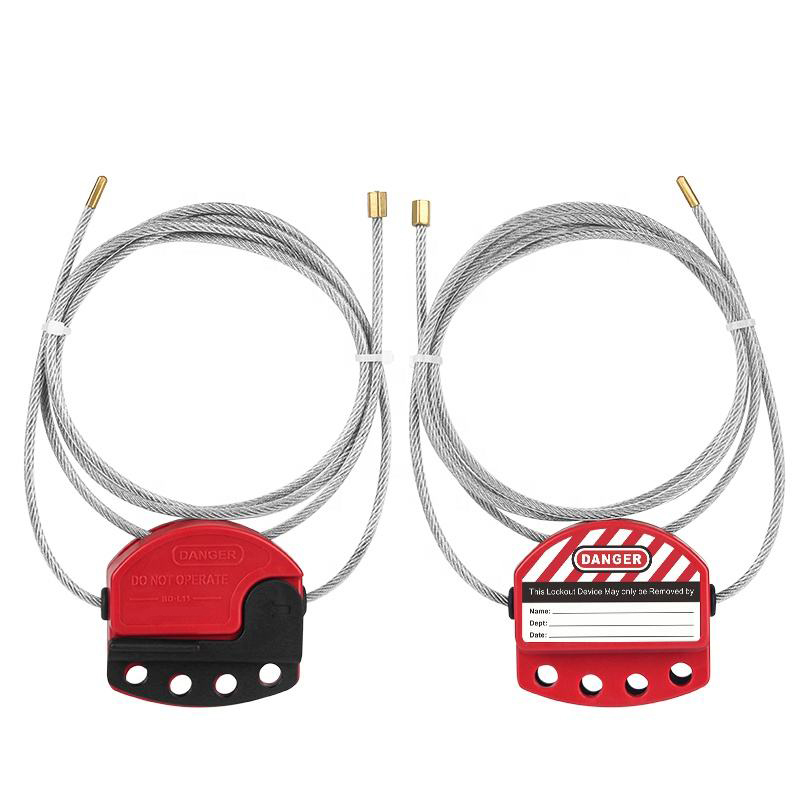In industrial environments where machinery and energy systems require regular maintenance or repair, safety is paramount. One of the most effective tools for ensuring worker protection during these tasks is the cable lockout system. Designed to isolate multiple energy sources simultaneously, cable lockouts offer flexibility, durability, and ease of use—making them a preferred alternative to rigid plastic devices or traditional metal chains.
This article explores how cable lockouts function, their design variations, and best practices for integrating them into your organization’s Lockout/Tagout (LOTO) program. Whether you're managing a small workshop or overseeing safety in a large-scale manufacturing plant, understanding how to properly apply cable lockouts can significantly reduce risk and enhance compliance with industry standards.
A cable lockout system is a flexible safety device used to secure energy-isolating points on machines and equipment. Unlike fixed lockout mechanisms, cable lockouts allow for adjustable length and positioning, making them suitable for a wide range of applications—from electrical panels to valve wheels and control switches.
These systems typically consist of a durable cable, a locking mechanism, and one or more padlocks that prevent unauthorized removal until all authorized personnel have completed their work.
The operation of a cable lockout is both simple and highly effective:
This ensures that no energy source can be reactivated without the consent of every individual involved in the maintenance process.
While many cable lockouts feature a plastic housing for lightweight portability and chemical resistance, metal-bodied versions are also available for extreme conditions such as high heat or steam environments. These models maintain the same functional integrity but offer enhanced thermal and mechanical resilience.
One of the standout features of cable lockout systems is their ability to support group lockout procedures. Most modern designs include provisions for 3–5 padlocks, allowing each technician or supervisor to apply their own personal lock before work begins. This ensures accountability and prevents premature release of stored energy.

Unlike rigid lockout devices, cable lockouts can conform to various shapes and sizes. This makes them ideal for securing complex machinery with irregular or multiple isolation points—such as valves with oversized handles or multi-switch control boxes.
Proper use of cable lockouts aligns with OSHA’s standard 29 CFR 1910.147, which outlines the requirements for controlling hazardous energy. By using a standardized and reliable method like cable lockouts, companies not only protect workers but also avoid regulatory penalties.
Because they eliminate the need for multiple specialized lockout tools, cable lockouts represent a cost-efficient investment. Their reusable nature and adaptability across different equipment types reduce inventory needs and streamline LOTO processes.
Step 1: Identify All Energy Isolation Points
Before any lockout procedure begins, identify all potential energy sources—including electrical, pneumatic, hydraulic, and mechanical—that could pose a hazard during maintenance.
Use a facility schematic or tagging system to ensure nothing is overlooked.
Step 2: Select the Appropriate Cable Type
Choose between:
Ensure the cable length is sufficient to wrap around the target components securely.
Step 3: Secure the Cable Lockout Device
Route the cable through or around the energy-isolating component (e.g., valve handle), then pull it tight and insert the free end into the locking base unit. Engage the clamping mechanism to hold the cable firmly in place.
Step 4: Apply a Safety Lock and Warning Tag
Once secured, affix a padlock and attach a warning tag. The tag should include:
This information helps maintain transparency and ensures proper coordination among team members.
Inspect cables regularly for signs of fraying, wear, or damage. Replace any compromised units immediately. Also, check locking mechanisms to ensure smooth operation and secure engagement.
Provide hands-on training for all personnel who will be applying or removing lockout devices. Emphasize the importance of following LOTO procedures rigorously to prevent accidents.
Maintain an inventory of replacement cables, padlocks, and tags. Quick access to spare parts minimizes downtime and supports continuous safe operations.
Here are some recommended cable lockout products based on common industrial needs:
Selecting the right product depends on your specific operational environment and safety requirements.
Cable lockouts are a vital component of any comprehensive Lockout/Tagout program. Their versatility, ease of use, and ability to accommodate multiple users make them indispensable in industries where machinery must be safely isolated during maintenance.
By understanding how these devices work and implementing them correctly, organizations can significantly reduce the risk of workplace injuries, improve regulatory compliance, and foster a culture of safety awareness.
With years of expertise, cutting-edge manufacturing, and a commitment to global safety standards, ELECPOPULAR SAFETY continues to be a trusted partner in industrial safety solutions. Whether you need standard lockout devices or customized OEM/ODM services, our team is ready to support your safety goals.
Contact us today to learn more about our product range, request a quote, or discuss your specific requirements. Let’s work together to create a safer working environment — because safety is not just our business, it’s our mission.
